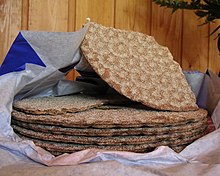Crispbread


Crisp bread or hard bread (Swedish: knäckebröd, hårt bröd, Danish: knækbrød, Norwegian: knekkebrød, Finnish: näkkileipä) is a flat and dry Nordic type of bread or cracker, containing mostly rye flour. It is popular in armies and schools because of its light weight and simple, transport-friendly shape. Also, it is very cheap and if stored in dry conditions it will keep fresh and edible for a very long time. Crisp bread is a staple of Nordic cuisine and was for a long time considered a poor man's diet. However, in recent years there has been renewed interest in crisp bread in the Nordic countries.
Origins
According to some sources[citation needed], crisp bread is more than a thousand years old and was a staple of the Vikings on their raids, as a ship biscuit would keep for several months.
Traditional crisp bread was invented about 500 years ago.
Ingredients
Crisp bread traditionally consists of wholemeal rye flour, salt and water.
Today, however, much crisp bread contains wheat flour, spices and grains, and is often leavened with yeast or sourdough.
In the case of unleavened crisp bread, bubbles are introduced into the dough mechanically.
Traditionally, this was done by mixing crushed ice into the dough, which then evaporated during baking. Today, the dough, which must contain a large amount of water, is cooled and mixed until bubbly.
Another method is to knead the dough under pressure in an extruder. The sudden drop in pressure then causes water to evaporate, creating bubbles in the dough.
Crisp bread is only baked for a few minutes, at temperatures usually between 200 and 250 °C.
